Open-source INFORM Index Provides Overview of Disaster Risk in North Macedonia
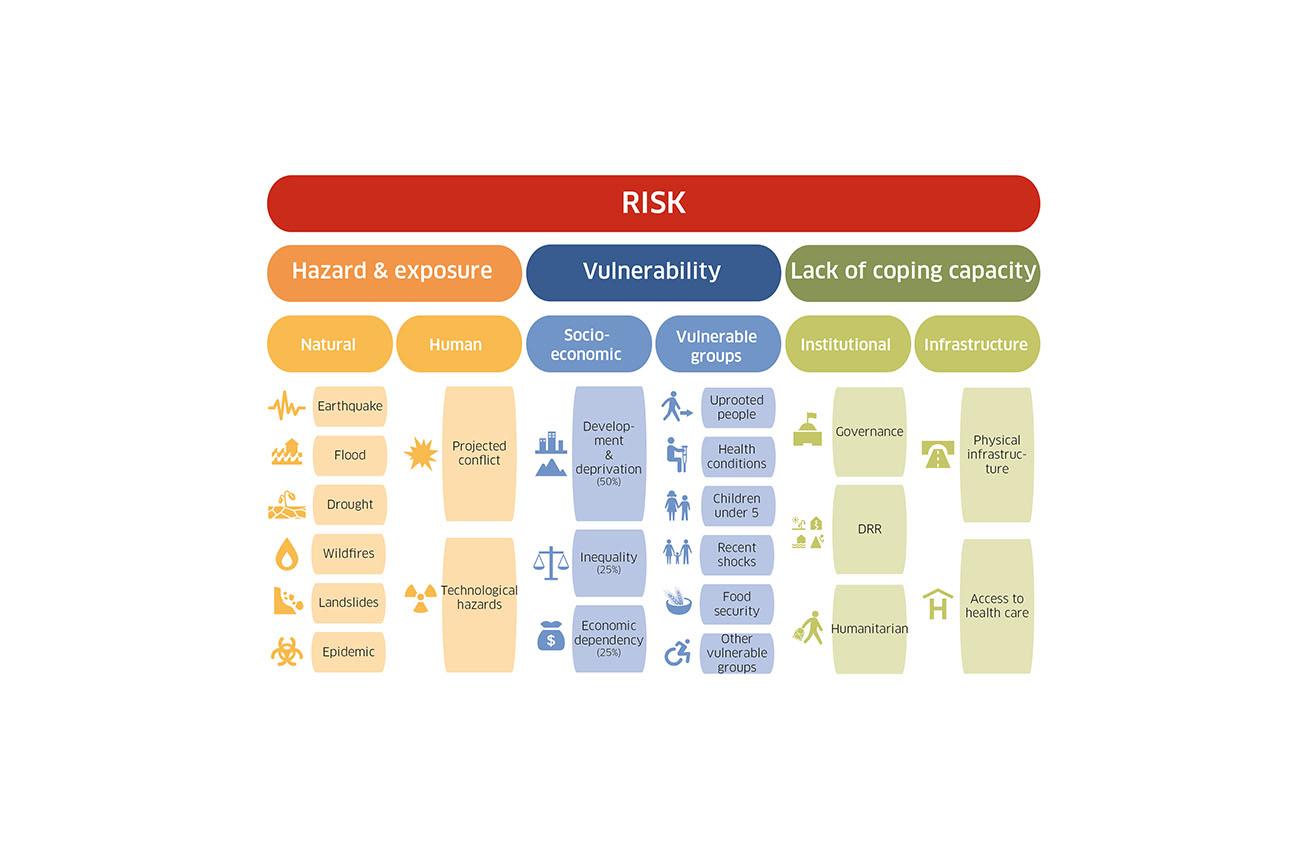
The INFORM Risk Index is a global, open-source risk assessment methodology for humanitarian crises and disasters.
Offering a high level picture of disaster risk, INFORM provides comparisons across a single region or country. It can be used by decision-makers to analyse and visualise risk, guide decisions on crisis and disaster response, preparedness, resilience – as well as sustainable development.
In November 2021, the subnational INFORM model was developed for three countries in Southeast Europe: Albania, Montenegro and North Macedonia. Created by the UNDRR Regional Office for Europe and Central Asia – in collaboration with the Secretariat of Disaster Preparedness and Prevention Initiative for South East Europe (DPPI SEE) – the INFORM model for South East Europe goes down to the first administrative level (corresponding to the subnational regions, capitals and municipalities) in the three countries for a total of 44 administrative units.
Overall, the INFORM Risk Index provides a proactive disaster risk management framework for the effective allocation of resources for disaster risk reduction and management – as well as actions focused on anticipating, mitigating, and preparing for humanitarian emergencies. It also identifies areas where national disaster data availability could be improved and shows compliance with implementation of Sendai Framework for DRR, the UN Sustainable Development Goals (UN SDGs) and other global initiatives. INFORM’s subnational methodology can contribute to national disaster risk reduction strategies, policies, support analysis, mobilize resources and plan activities.
Focus on North Macedonia
INFORM’s risk analysis focused on North Macedonia’s eight statistical regions: Northeast, Polog, Skopje, Southwest, Southeast, Vardar, East, and Pelagonia. According to recent and historical records, North Macedonia is at risk from various natural hazards, including: earthquakes, floods, torrents, landslides, rockfalls, avalanches, droughts, as well as heatwaves and cold waves. The COVID-19 pandemic, migrant crisis and wildfires in 2020 also took a significant tool on the territory – on the healthcare sector and the economy as a whole, limiting North Macedonia’s capacity to cope with crisis.
Producing the INFORM Subnational Risk Index for North Macedonia represents an essential tool for policymakers to identify the weakest links in the system and inform evidence-based policy response, helping the country become better prepared for humanitarian, climate change and socio-economic challenges in the long-term.
INFORM groups risk into three dimensions – Hazard & Exposure, Vulnerability and Coping Capacity – which branches into six categories and further specific components most relevant to South East Europe (see Figure 1 below). The Risk Index for North Macedonia’s eight subnational regions looks at 68 different indicators.
The Risk Index is ranked from 0 (lowest risk) to 10 (the highest risk level) then grouped into five risk classes: very low, low, medium, high and very high. Based on INFORM’s results, most of the subnational regions were assessed as medium risk . However, due to a higher risk ranking in the Hazard & Exposure and Coping Capacity dimensions, Skopje and Polog are regions classified as high risk (see Figure 1 and Table 1 below).
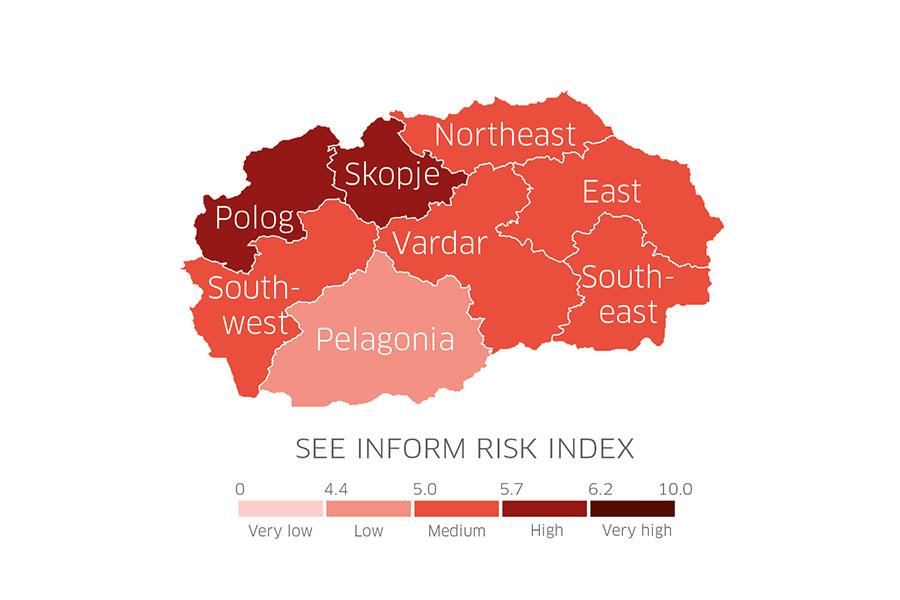
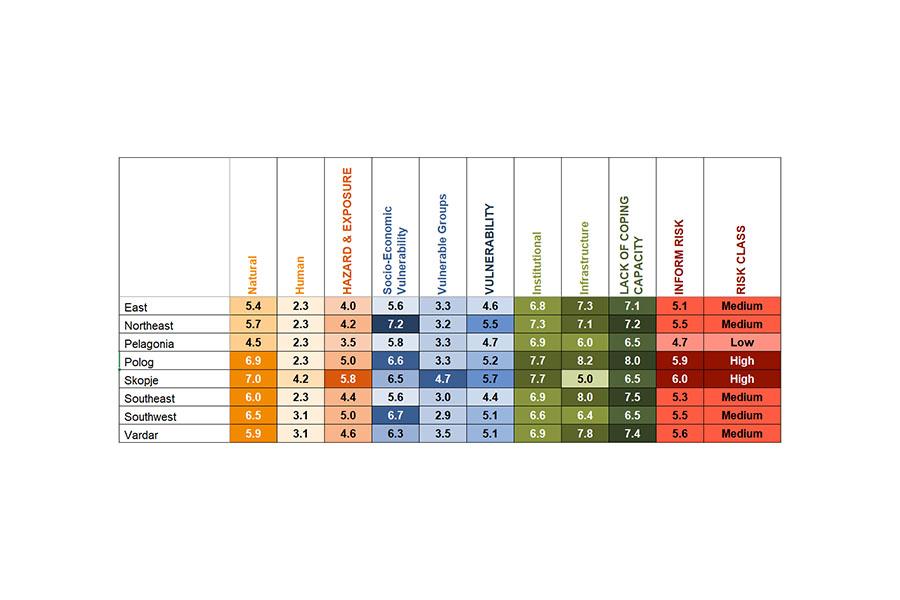
North Macedonia disaster risk analysis
The Hazard & Exposure dimension measures natural and human hazardous events that could occur – as well as the people or assets potentially affected by them. Figure 2 shows that in North Macedonia, this dimension is driven by natural hazards, mainly drought across all regions. When combined with earthquake risks in the Skopje and Polog regions alongside nationwide landslide exposure, North Macedonia has an overall high risk of Hazard & Exposure.
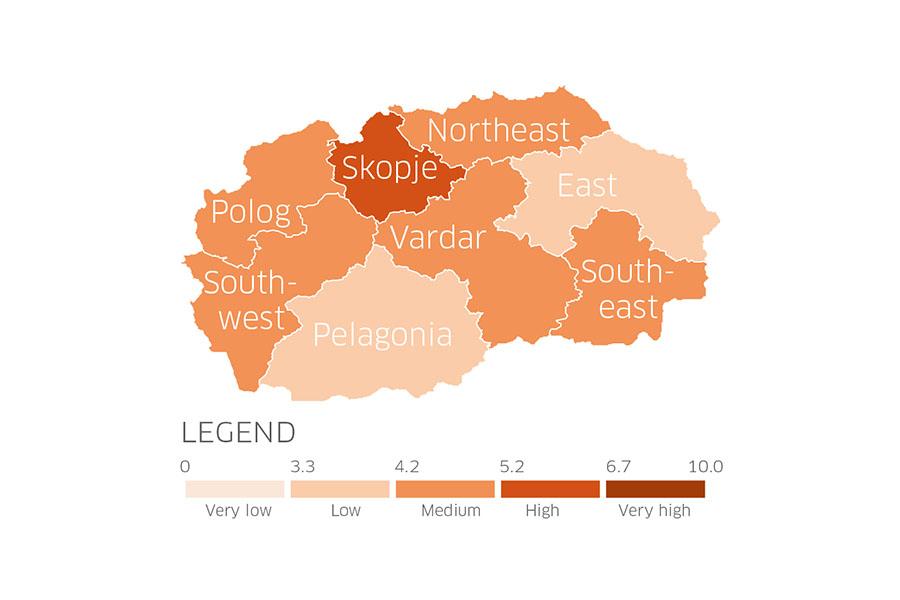
With the exception of the Skopje and Northeast regions, North Macedonia has a medium Vulnerability risk. Socio-economic vulnerabilities such as unemployment risk and a large proportion of social protection beneficiaries push regions into a higher risk. A high national score on food (in)stability also contributes to increased vulnerability.
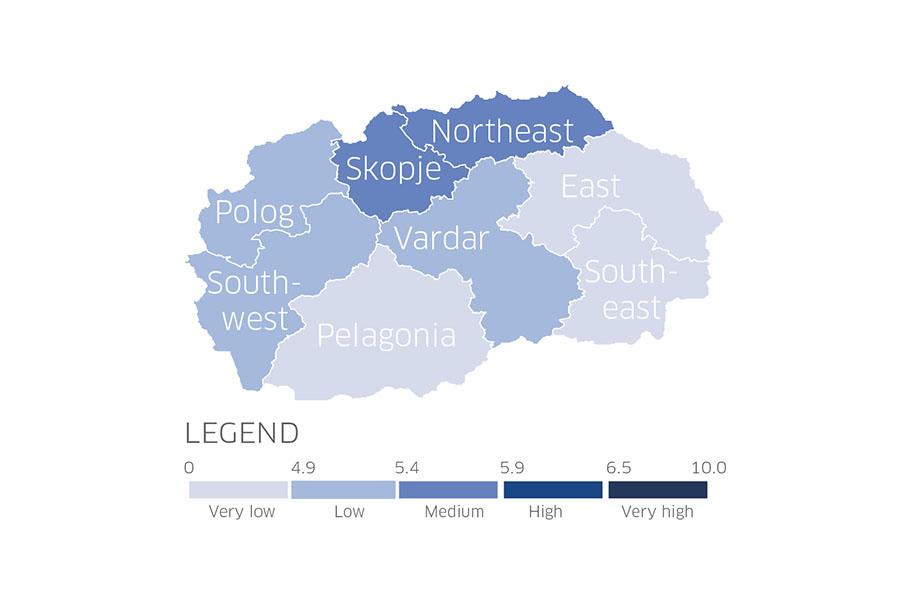
Coping Capacity can be improved through governmental action. Vardar, Northeast, Southeast and Polog are in the very high risk class, due to issues with infrastructure such as physical road connectivity. This dimension’s institutional component indicates a high risk of coping capacity – even though the governance component score at national level is more satisfactory. Also, a lack of indicators for the DRR component (under custodianship of Sendai and DesInventar) limits further analysis of the country’s coping capacity.
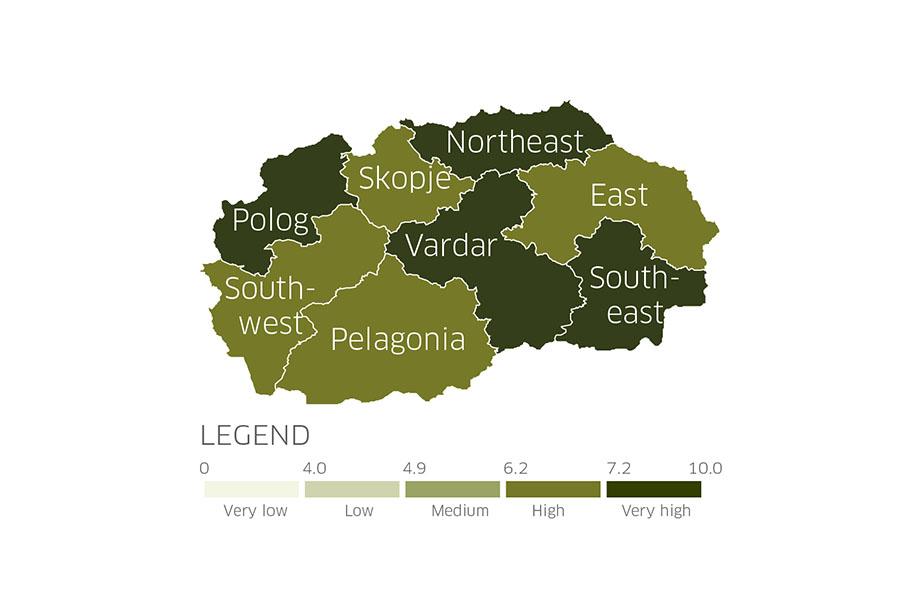
Summarizing INFORM’s North Macedonia results
It is easier for North Macedonia to address the Vulnerability or Coping Capacity dimensions than Hazard & Exposure. Improving socio-economic development more sustainably by strengthening sectorial policies (social or health policy) can lead to vulnerability reduction. Also, Coping Capacity can be improved by further developing the country’s infrastructure such as road connectivity or promoting activism though increased interest in volunteerism (humanitarian component) or improving health capacities (healthcare component).
Collaboratively developed, with results shared openly, the INFORM South East Europe (SEE) Risk Index results for North Macedonia provide valuable input into any analysis which supports planning and resource allocation processes. It is particularly useful for supporting decision-making processes such as strategic humanitarian, development or government planning.
INFORM subnational session at EFDRR
The INFORM Subnational Risk Index results for South East Europe were presented at the European Forum for Disaster Risk Reduction (EFDRR) in Matosinhos, Portugal on 24-26 November 2021.
EFDRR forms the regional platform structure of Europe. The triennial EFDRR is an important vehicle to address regional disaster risk challenges, serving as a forum for stakeholders to take shared responsibility and make actionable commitments to reduce disaster risk. True to the multi-stakeholder spirit of the Sendai Framework, the conference enables governments and stakeholders to exchange knowledge and innovative approaches to prevent, reduce and manage disaster risk.
Mr. Vlatko Jovanovski, the Head of the DPPI SEE Secretariat, indicated: “Results of the INFORM Subnational Risk results are important for SEE and DPPI countries because: (1) they are developed with joint cooperation between national authorities, UN agencies are regional entities (2) they came from consultation, which created a sense of ownership of the model and its outcomes.”
The INFORM session featured speakers from the European Commission (EC) Joint Research Centre (JRC), the DPPI SEE Secretariat, the Center for Emergency Situations and Disaster Risk Reduction (CESDRR), the South-eastern Europe Health Network (SEEHN) Secretariat, the UNDRR, the National Civil Protection Agency of Albania, the U.S. Agency for International Development (USAID) and the EC’s Directorate-General for European Civil Protection and Humanitarian Aid Operations (DG ECHO).
These results aim to develop a common understanding of risk, highlight vulnerable areas and boost understanding of the underlying risk drivers. The findings can be used to address the root causes of risk and improve DRR strategies at a regional and national level, dealing with long-term risk reduction.
Highlighting the importance of joint efforts to address country needs, Ms. Mira Dasic, Head of SEEHN Secretariat, added: “We shall back our communication efforts with solutions by providing capacity building to countries – or even dive in and select riskier regions – to enhance capacity and ensure knowledge and practice transfer from better-off regions to the less safe ones.”
Additional information:
- For more information and detailed INFORM SEE 2021 results, visit: INFORM subnational risk index for SEE 2021 and the country dashboard for North Macedonia
- To access the INFORM session recording at European Forum for DRR on 24 November 2021, follow this link
Contact details:
- Mrs. Galiya Ibragimova, INFORM Data Management Regional Coordinator, UNDRR ROECA (galiya.ibragimova@un.org);
- Mr. Nicholas Joseph Ramos, Program Management Officer, UNDRR ROECA (nicholasjoseph.ramos@un.org);


